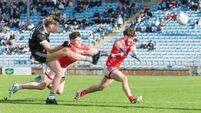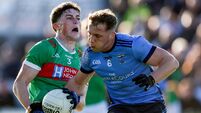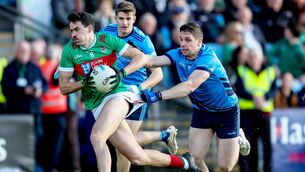Frank was an enduring link to Mayo's golden era
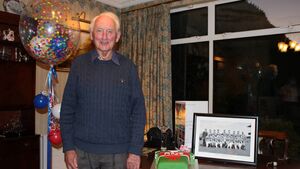
Frank Fleming is pictured on the occasion of his 90th birthday at the height of the Covid-19 pandemic in 2020. The photograph on the table is of the Mayo team that played Dublin in the All-Ireland semi-final in 1955.
Frank Fleming, who passed away in Dublin on August 5th last, was one of the last links to Mayo GAA’s golden era of the early 1950s.
Although he did not feature on the Mayo senior team that won back-to-back All-Ireland titles in 1950 and 1951, Frank was a contemporary of those great players and lined out with them just a few weeks after the All-Ireland Final victory over Meath in the autumn of 1951.
A native of Kilcolman in Claremorris, Frank featured at right-half back on the Mayo junior team that reached the All-Ireland Final in 1951 after a thrilling draw and victory over Dublin in the semi-final. The final against Cork took place just weeks before the senior team’s encounter with Meath and Frank had many happy memories of training sessions in Ballina under the watchful eyes of Gerald Courell and Jackie Carney. The junior and senior teams trained together and there was no quarter asked or given.
Unfortunately, the Mayo junior team lost narrowly to Cork, but Frank was immediately drafted into the senior team for the National League campaign. He made his debut for the All-Ireland champions against Clare in Charlestown on October 21, 1951, a game Mayo won easily by 5-6 to 1-0 with Tom Langan and Mick Flanagan each scoring a brace of goals.
Frank was working in Dublin at the time and playing with the Westerns GAA Club, which consisted of “country players” residing in the city.
“We had no clubhouse, no pitch, no nothing,” he recalled in an interview with the in 2016. “But we had a good team. We had seven guys who were playing Railway Cup, including the likes of Gerry O’Malley from Roscommon and Tom Dillon from Galway.
“The Dublin club championship was huge in those days and was dominated by St Vincent’s who had 14 players on the Dublin senior team – the exception being the goalkeeper!”
Frank recalled attending Dublin club matches in Croke Park on Friday evenings when thousands of people would turn out to see St Vincent’s take on the Garda club, which also included a lot of ‘country footballers’, including the Mayo legend Tom Langan.
“I saw Langan get a goal from 40 yards against St Vincent’s in Croke Park when there were thousands and thousands of people there. Tom was hugely respected in Dublin club football. He was a wonderful footballer.”
Frank featured for Mayo during the National League campaign in 1951-’52 and made his Croke Park debut in a league semi-final against Kerry on March 9th, 1952, lining out alongside iconic figures like Langan, Seán Flanagan, Padraig Carney and Paddy Prendergast.
The Claremorris man was fortunate to arrive on the Mayo team when it was in its pomp, and the legendary Henry Dixon, also from Claremorris, joined him in the half-back line.
“Dixon was a pleasure to play beside. He just stayed in the middle, let nobody pass, and let Ned Moriarity and myself do the running. We were young and he was old. They say he didn’t take up football till he was 36!”
Mayo suffered a shock defeat to Roscommon in the Connacht Final at MacHale Park in Castlebar in July 1952 when a third successive All-Ireland title seemed to be on the cards. Frank didn’t feature in the first championship game of that summer – a victory over Sligo – but came on as a substitute in the provincial decider.
“I believe we would have won the All-Ireland had we got over Roscommon,” he recalled. “We still had a very good team, and we were competitive right up to 1955 when we again should have lifted Sam Maguire.”
Frank spent a lot of time training on his own in Dublin in preparation for Mayo’s big championship games in the mid-1950s.
“I’d train in the bushes in the Phoenix Park,” he recalled. “I’d be running like hell and pretending the trees were players, so I’d be trying to dodge them but sometimes it was so wet I’d end up running into them.”
Described by the in 1955 as “one of the most fearless defenders playing the game", Frank made his full senior championship debut in 1953 in a victory over Sligo, but more disappointment was to follow when the men in green and red lost another provincial decider to Roscommon.
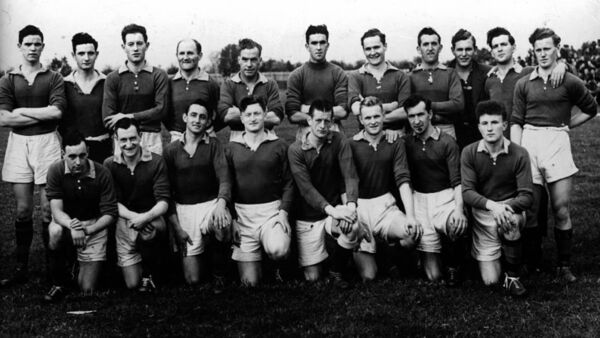
Consolation came in the form of a fantastic National League campaign that ended with victory over Carlow in the final in Croke Park in April 1954. A few weeks earlier, Padraig Carney had made history when he flew from New York to line out against Dublin in the league semi-final. In an era when air travel was still a novelty, Carney’s exploits were front-page news and prompted the legendary commentator Micheál O’Hehir to christen him ‘The Flying Doctor’. Frank recalled going to Croke Park with Carney on the day before the league semi-final against Dublin to practice free-taking – Frank’s job was to return the ball to his idol.
“Carney would have taken an eight to ten-hour flight from New York that involved a refuelling stop in Newfoundland. He then had to travel from Shannon up to Dublin. Yet the first thing he’d want to do was to go over to Croke Park so he could practice his frees.”
The practice certainly worked because Carney scored seven of Mayo’s 11 points in the league semi-final, including four frees and a ‘50’. He followed it up with another four points, including two frees, in the final, which was the last time he played for Mayo on Irish soil.
The prize for new league champions was a trip to the United States, one of several overseas trips that Frank undertook as a footballer and GAA official. His most memorable year in the green and red came in 1955 when Mayo recaptured the Connacht senior championship for the first time since 1951. They went on to contest the All-Ireland semi-final against a Dublin team that included Kevin Heffernan at full-forward and Ollie Freaney, who Frank had many battles with in club football. The game ended in a draw and Mayo lost the replay by a single point, 1-8 to 1-7, in front of a crowd of 84,000.
“John Nallen played brilliantly the first day. We won everything at midfield, but we couldn’t put the ball over the bar. In the replay, I got injured when the Dublin player Nicky Maher ran into me. Nicky always wore goggles and whatever way we collided the goggles got me across my eye, and I was pumping blood. A Cavan man [Cavan were playing Kerry in the second semi-final] came on the pitch with a handkerchief! I was taken to the Mater Hospital afterwards for stitches.”
The game is also remembered for the exploits of Frank’s fellow Claremorris man, Jimmy Curran, who kicked all his team’s scores.
The late 1950s was a barren period for Mayo football but Frank continued to line out in the Green and Red, hiring a car each week to travel west for games with his native county. He also played for Claremorris for a period before transferring to Civil Service in Dublin, later becoming a renowned administrator and organiser for the club. Indeed, Frank was the prime mover behind Civil Service’s six different trips to America from 1966 to 1981 and can even claim to have played Gaelic football in Honolulu.
Frank made his home in Clontarf, but always kept a close eye on Mayo football and was a key figure in the Mayo Association in Dublin. Like so many of his generation, his dream was to see a new generation of Mayo senior footballers climb the steps of the Hogan Stand on All-Ireland Final day.
A man of great decency and kindness, Frank raised a huge amount of money for Western Care Association, the Cheshire Homes Foundation and many other charities in Mayo.
The Civil Service Club in Dublin paid the following tribute to Frank:
“Frank was a dearly loved and highly respected member of our club over many decades and made an outstanding contribution both on and off the field of play. As an administrator and innovator, he was without parallel.
“Frank’ s contribution was best described in the words of his great friend and our former chairperson, Tom Crotty (RIP) in the pages of our club’s history:
‘Frank masterminded the club’s six unforgettable trips to the United States, Canada and Hawaii.
‘It is fair to say that without his guile, expertise and guidance, many Civil Service footballers would not have savoured the pleasure of playing our games in cities as far apart as New York and San Francisco, Montreal and Los Angeles, Toronto and Chicago.
‘Without his vision and ‘never say die’ approach [they] might never had the opportunity to visit and forge friendships in such places as Seattle, Boston, Hartford, Honolulu, Vancouver and Las Vegas.
‘To Frank, our club owes a deep debt of gratitude as, indeed, does the Association for the benefits reaped from his undoubted ambassadorial talents and organisational skills; and for a lifetime of dedication to Cumann Lúthcleas Gael both as a player and administrator.’”
Predeceased by his wife of 64 years Kay and his brother John, Frank Fleming is survived by his children Máire, Gabriel, David, Neil and Orla, daughters-in-law Maitland, Carol and Rhona, son-in-law Friedrich, grandchildren Andrew, Lois, Alex, Adam, Mark, Lucian, Oisín, Cian and Serena, sisters Bridie and Ann and extended family, relatives and good neighbours.
His funeral service took place in Dublin.
May his gentle soul rest in peace.
